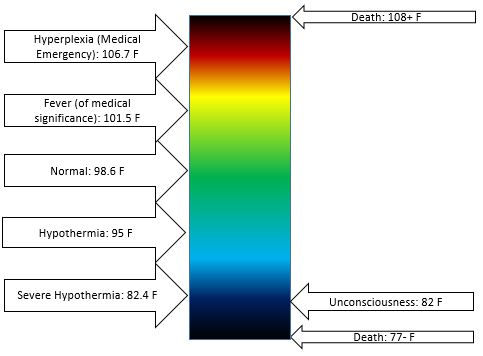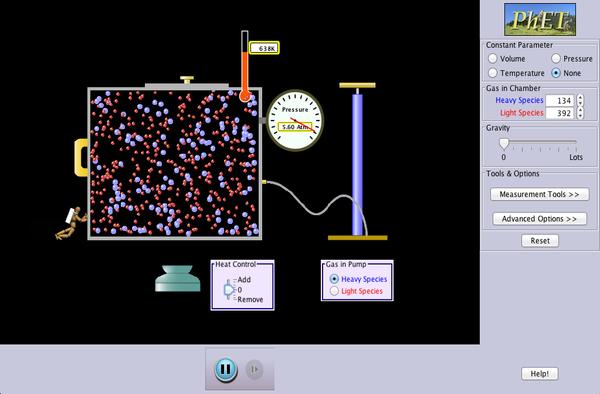11.4: Homeostasis, Hypothermia, and Heatstroke
- Page ID
- 17805
Homeostatis
In the previous unit we learned that the body is at best only 25 % efficient at converting chemical potential energy to useful work. The other 75% of the chemical potential energy becomes thermal energy, which the body exploits to manage body temperature as a part of homeostasis, or the body’s act of maintaining a relatively constant internal environment. Thermal injuries occur when body temperature becomes to high or too low, but our body has strategies for preventing that from occuring.

False-color scale indicating medically-relevant body temperature thresholds. Image Credit:Human Body Temperature Scale by Foxtrot620 via Wikimedia Commons
In order to analyze our body’s response to different environmental temperatures we need to first define temperature and clear up the definitions for some other thermodynamic quantities:
- Thermal energy(TE): Kinetic energy stored in the microscopic motion of atoms and molecules. The SI unit for thermal energy is Joules (J), though it is sometimes measured in calories or British Thermal Units (BTU)
- Temperature (T): A measure of the average thermal energy per atom or molecule. The SI unit for Temperature is Kelvin (K), though it is often measured in Celsius (°C) or degrees Fahrenheit (°F).
- Heat(Q):The amount of thermal energy transferred between an object and its environment due to a difference in the object and environment temperatures. The units for heat are the same as for thermal energy.
- Thermal Equilibrium: A state where the rate of heat transfer is zero because object and environmental temperatures are the same.
Reinforcement Exercise
Read the following paragraph about forces and translational equilibrium. Then fill in the blanks in the following paragraphs about rotational equilibrium and thermal equilibrium.
An object in translational equilibrium experiences no net force. That doesn’t mean no force is applied, it just means that all the forces cancel out, which occurs when there are equal amounts of force in each direction.
An object in rotational equilibrium experiences no net _____________. That doesn’t mean no __________is applied, it just means that all the __________ cancel out, which occurs when there are equal amounts of ____________in each direction.
An object in thermal equilibrium with its environment experiences no net _____________. That doesn’t mean no __________is transferred, it just means that equal amounts of __________are transferred in and out of the object, which occurs when the object and environment have equal ______________.
The following simulation allows you to visualize how temperature and atomic motion are related.
Thermal Injuries
Now that we have solid definitions for thermal energy, heat, temperature, and thermal equilibrium, we can follow the progression of thermal injuries:
- As a measure of the average motion of atoms and molecules, temperature influences the rate of chemical reactions and the ability of molecules, such as proteins, to remain in a particular shape.
- Due to the above, the body must maintain a relatively narrow range of temperature in order to function properly.
- The body is inefficient and thus converts chemical potential energy to primarily thermal energy as part of basic metabolism and when doing useful work.
- If heat transfer is limited, then thermal energy will build up in the body and temperature will increase, possibly resulting in hyperthermia and heat-related injuries such as heat stroke. We will learn to prevent hyperthermia by understanding how and when heat transfer to the environment is limited in the following chapters.
- If instead, heat is transferred to the environment faster than thermal energy can be converted from chemical potential energy, then body temperature falls, possibly leading to hypothermia and cold-related injuries such as frost-bite. We will learn to prevent hypothermia by understanding how and when heat transfer to the environment can become too fast in the following chapters.
- Human Body Temperature Scale by Foxtrot620 [CC BY-SA 4.0 (https://creativecommons.org/licenses/by-sa/4.0)], from Wikimedia Commons↵



